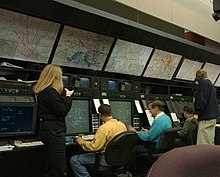Area Control Center
The Area Control Center (abbreviated ACC or Center ), in Germany also district control center (in the USA Air Route Traffic Control Center , ARTCC), are air traffic control centers that control the en-route air traffic in the assigned airspace ( flight information area , FIR). Center controllers take over aircraft after take-off from the tower controller at the airfield and, after they have passed through their own sector, hand them over to a neighboring center or to a tower immediately before landing. Centers differ in those for the lower airspace (up to about 8 km, flight level 245) and those for the upper airspace, called UAC (Upper Area Control Center). They are usually operated as state institutions, but the German air traffic control system responsible for this in Germany is a leased company. The tasks and areas of responsibility of the Area Control Centers are determined by the ICAO .
task
The air traffic controllers in the center direct the air traffic with the help of instructions (clearances) that are transmitted to the pilots by radio or direct data transmission (data link) . For the visual representation of air traffic on vision devices, the controllers have radar or satellite-based detection systems. Numerous other technical systems, such as ground and airborne collision warning systems, support the work.
Traditionally, the centers are responsible for enroute traffic. This is the part of a flight profile in which an aircraft has ended the climb phase after take-off and goes into cross-country flight. Conversely, the cross-country flight ends when the flight profile changes to the descent phase for approach and landing. Again it has to be said that this definition can hardly be maintained due to the performance data of modern high-performance aircraft. The climb phases on the so-called departure routes usually only end at altitudes above 8 km. Conversely, for economic reasons, pilots want to start the descent as late as possible and keep it as continuous as possible until shortly before landing. The processes of redesigning and harmonizing European airspaces take these changing conditions into account and will probably lead to a far-reaching reorganization of the airspaces and thus the areas of responsibility in the near future.
organization

Depending on the size of the national territory, one or more Area Control Centers share the airspaces to be processed. There are also a few transnational institutions, for example in Maastricht.
Germany
Germany has three ACC ( Munich , Bremen and Langen ) and two UACC ( Karlsruhe and Maastricht ). The three ACC and the UACC Karlsruhe are operated by Deutsche Flugsicherung (DFS). The center in Langen has been the largest control center in Europe since 1999. UACC Maastricht is a special case in the European air traffic control world and is not operated by DFS, but by the European air traffic control agency Eurocontrol . The control point in Maastricht, the Netherlands, controls the upper airspace of the Benelux countries and over northern Germany.
Austria
Austria has an ACC in Vienna .
Switzerland
The Switzerland has ever ACC in Zurich and Geneva .
Neighboring European countries
In the west are the ACC Amsterdam , Brussels and Reims , in the south Milan and Ljubljana , in the east Prague and Budapest , to name but a few.
The "handover" of the aircraft to the next ACC is regulated by international procedures across national borders.
If the type of air traffic or the location of the airspace requires it, the responsibilities of air traffic control are completely delegated to neighboring centers. For example, the Swiss air traffic control organization Skyguide controls parts of the southern German and eastern French airspace, the German center in Munich is responsible for certain overflights of the western Austrian airspace.
United States
There are 22 centers in the United States operated by the Federal Aviation Administration (FAA). These are called the Air Route Traffic Control Center (ARTCC).
Canada
Canada has seven centers operated by NAV CANADA . The seven centers are in Edmonton , Gander , Moncton , Montreal , Toronto , Vancouver and Winnipeg .
Division of labor of the ACC
Internally, the ACC are divided into several control sectors. For example, Munich Information is divided into three sectors:
- The southern sector (frequency 126.950 MHz) begins at the Alps (north of ACC Vienna or ACC Zurich on Lake Constance) and extends roughly to the Munich airport and Augsburg airfield .
- The middle sector (frequency 120.650 MHz) begins there and extends to Nuremberg Airport .
- The northern sector of Munich Information (frequency 125.800 MHz) begins there and extends to the Harz in the north . The ACC Bremen (Bremen Information) begins north of it.
Two air traffic controllers usually perform their tasks in the sectors:
- One of the two, the planning or coordinator controller, plans the air traffic using the flight data available and coordinates the planned flight profiles with the neighboring sectors.
- The other, the radar or executive controller (executive controller) takes over the tactical control of air traffic, is responsible for the separation between the aircraft and is in direct contact with the pilots via radio.
Further tasks
During the flight, the flight information service FIS ( Flight Information Service ) is offered in controlled and uncontrolled airspace for flights according to visual flight (VFR) as well as for flights according to instrument flight rules (IFR). On the ground, before the flight, the flight information service AIS (Aeronautical Information Service) is offered. In terms of the scope and nature of the information offered, both services are the same, the "AIS" is on the ground before the flight, the "FIS" is available during the flight.
Web links
Responsible for German airspace:
For Austria and Switzerland:
Individual evidence
- ↑ Official designation according to ICAO, cf. Air Traffic Services Planning Manual , p. 209
